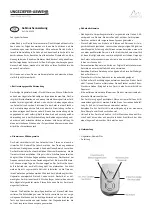
DS1067-063D
30
LBT20064
2.3
THE DEVICES USED TO CREATE AN ALARM SYSTEM
Essentially, an intrusion alarm system consists of four types of components:
the control panel;
the detectors;
the signalling devices;
the complementary devices.
These components are generally separate, but sometimes a single device may enclose more than one.
Below are illustrations of these components: what they are called, how they are made, and how they work.
2.3.1
The control panel
The control panel is the "brain" of the system and has various functions:
it interprets different signals that arrive from the detectors and then takes the most appropriate action, like ignoring
the opening of a window if the system is disarmed or activating notification devices if it is opened while the system is
armed;
check that all the system devices are always functioning correctly;
signal potential anomalies that may threaten security and the functionality of the system;
record all the main events.
An intrusion alarm system only has one control panel.
2.3.2
The detectors
The detectors are devices capable of detecting changes - voluntary or involuntary - that an element or physical
characteristic of the environment where they are installed may undergo. A detector has one or more sensors that
perceive these changes.
The detectors must be designed and installed so as to maximise the detection and minimise the risk of false alarms.
For the alarm system, the detectors are equivalent to our senses.
The detectors may distinguish events according to:
a functioning principle;
a type of change that must be signalled;
where they must be applied and what they must control;
the physical characteristics of the environment they must monitor.
2.3.2.1
Button
This is absolutely the easiest detector to use. There are all types available, from those that are activated manually, those
that must be pulled, and those that can be pressed by foot. It is sometimes and extension of a more advanced detector.
2.3.2.2
Magnetic contact (reed)
This contact is used to control the opening of doors and windows. The opening sensor has two parts: a magnet and a
blade contact, or something similar. When they are placed next to each other, at a distance of a few millimetres, the
magnetic field of the magnet keeps the blade contact in position to close the electrical circuit. Separating them reduces
the force of the magnetic field, the blade is no longer in position, and the electric circuit is broken, generating an openin g
signal. The magnet is applied to the door or casement and the magnetic contact is applied to the frame, as far as
possible from the hinges, so that even slightly opening the door or window may break the circuit. There are various
models available to meet a wide range of aesthetic and technical demands (wooden doors and windows, security doors,
sunken contacts, etc.). This detector is used mainly to create perimeter protection.
2.3.2.3
Cable contacts for rollers
The detector is installed inside the roller box. The sensor is an impulse counter that is paired with an automatic cable
winder. By connecting the end of the thin cable to the lower part of the roller, each time the blind is raised or lowered, the
cable winder turns and generates the impulses detected to the counter. Depending on the number of impulses generated
during a specific interval, the detector can signal an attempted intrusion. This type of detector makes it possible to keep
the windows open and the rollers closed to help air to circulate, thereby guaranteeing perimeter protection.
2.3.2.4
Broken glass detector
This detector can be created using various technologies and exploiting different principles of physics. For example, it can
detect the oscillations caused by the breaking or cutting of glass when it is glued to the glass or crystal to be protected,
or detect the characteristic sound waves generated by glass breaking, when it is positioned in the immediate vicinity. It is
used to signal the breaking of shop or showcase windows, large plate glass windows and skylights for perimeter
protection, but also for breaking of bulletin boards and display cases inside buildings.
Содержание 1067/024
Страница 118: ...DS1067 063D 118 LBT20064...
Страница 119: ...DS1067 063D 119 LBT20064...
















































